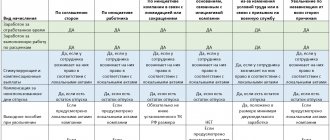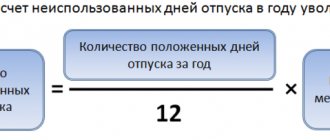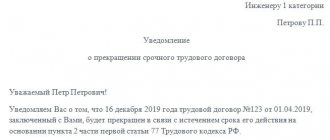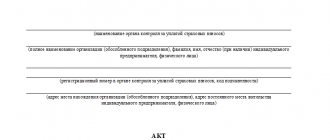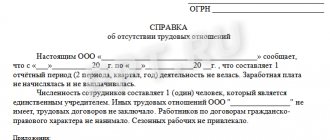Final settlements upon termination of an employment contract must be completed on the last day of work of the dismissed specialist. Moreover, this type of payment is non-declaratory in nature. That is, the employee is not required to indicate a request for money in his resignation letter. However, as practice shows, in some cases you will still have to prepare a sample application for payment upon dismissal.
A written application for payment of the final payment upon dismissal is an employee’s request to the employer with a request to give him the money due for the time actually worked, as well as compensation for unused vacations.
Why do you need an application?
A sample request for payment upon dismissal will be needed if the specialist did not work (was absent from the workplace) on the day of dismissal. For example, he took the remaining vacation days off, was on sick leave, or was absent for other reasons.
You will also have to write a statement if the employee did not show up at the appointed time to receive his dismissal money or does not agree with the amount of the final payments.
Articles on the topic (click to view)
- What to do and where to go if you are not paid upon dismissal
- What to do if you are laid off at work
- What to do if the employer does not want to fire at his own request
- What to do if the date of the dismissal order is later than the date of dismissal
- What to do if the employer does not give the work book after dismissal
- What to do if you didn’t work officially, you were fired, you didn’t get paid
- What is the employer obliged to give the employee on the day of dismissal?
The result of processing the claim will be an order for settlement upon dismissal and payment of the money due.
Submitting a claim for payment of wages
Employees go to court with monetary claims in the following cases:
- the employer delays wages or does not pay them in full;
- due dismissal payments have not been received;
- the employee was deprived of his bonus or fined.
When filing claims for recovery of wages, citizens can choose the jurisdiction at their own discretion.
Submit your application to the district court at your place of residence or location of your business. Write the application by hand or type it on a computer.
Attach to it copies of the documents you refer to in support of your claims:
- employment contract;
- The order of acceptance to work;
- wage regulations;
- orders/instructions of the employer;
- salary certificates.
The employer is obliged to issue copies of documents upon written application within three days. If the papers are not provided, the court will request them at your request. When an employee files a claim for recovery of wages, no state duty is charged.
For drawing up a statement of claim, a lawyer will charge from 1,000 to 3,000 rubles. The participation of a lawyer in a court hearing costs at least 5,000 rubles per day.
Example situation
Termination of the employment contract falls on 07/20/2018. This day is the last working day for the specialist. The accountant prepared a package of documents and certificates that need to be issued upon dismissal, and also wrote out funds to the cash desk for processing and issuing mutual settlements. However, the employee did not show up for the money; for example, he fell ill and went to a medical institution to issue a certificate of incapacity for work. In this case, the accountant is obliged to deposit the funds that were prepared for the dismissed person into the current account. Payments must be made no later than the next day after receiving a written request from the former employee.
Procedure for dismissing an employee
Dismissal is a process in which both the employee and the employer are required to comply with certain regulations. A certain procedure must be followed both in relation to the termination of an employment agreement and in relation to the payment of material obligations to the employee. The employer is obliged to pay the employee in full upon dismissal, and the calculation includes not only the salary for the period of time worked, but also various types of compensation (for example, for vacation not taken) and severance pay (if this payment is provided upon dismissal).
How to make an application
Expert opinion
Polyakov Pyotr Borisovich
Lawyer with 6 years of experience. Specialization: civil law. More than 3 years of experience in drafting contracts.
Legislators have not approved a special form for such an appeal. Therefore, you will have to prepare your application in free time. However, when compiling, be guided by the following rules:
This is important to know: Report on dismissal from the FSB
- The document can be handwritten or prepared using printing technology.
- In the header of the application, indicate the position and full name. the head of the employing organization, then write down the name of the institution.
- Now write down information about the applicant: full name, address, passport details.
- In the middle of the new line, enter the name of the document.
- We write the text of the document on a new line: we describe the essence of the appeal in detail. Be sure to write down the position of the dismissed person and the periods of his work in this institution. Then indicate the reason why you did not show up for the money on the appointed day, or write down a claim regarding disagreement with the amount of the estimated payment.
- List the documents that you are attaching to your application as confirmation. For example, indicate the number and date of the sick leave or the name and date of the mathematical calculation of the expected amount of payments.
- Put your handwritten signature and indicate the date the document was compiled.
Hand over the completed paper to the employer personally or hand it to his official representative. For example, give it to your secretary, HR officer or accountant.
Let's sum it up
Application for non-payment of compensation upon dismissal:
- written by an employee whose rights have been violated;
- drawn up in free form or filled out in a special format on the website Onlineinspektsiya.rf;
- sent to the authorities that, by law, have the right to force the employer to settle payments with the employee: the labor inspectorate, the prosecutor's office or the court;
- may entail an unscheduled inspection of the employer by supervisory and control authorities, which, if the fact of violation of the employee’s labor rights is proven, threatens the employer with punishment under Art. 5.27 Code of Administrative Offenses of the Russian Federation and Art. 145.1 of the Criminal Code of the Russian Federation.
If you find an error, please select a piece of text and press Ctrl+Enter.
In what cases should you write
As a rule, all payments to company employees are made through banks. Therefore, as a rule, employees do not have problems with timely receipt of payments. But some companies still continue to issue salaries to their employees through the accounting department.
As mentioned above, the employer is obliged to give the employee a full payment on the last day of his stay at the enterprise. But situations are not uncommon when, for one reason or another, a person cannot receive money on the due day. For example:
- due to personal circumstances, for example illness;
- due to delay in payments by the employer;
- if the employee disagrees with the amount of payments received.
In such cases, the employee should write a request for payment upon dismissal.
How to submit a request
You can transfer the document to the employer in different ways:
- the most reliable and fastest way is best - personally from hand to hand to a responsible employee of the company right at his workplace;
- send the demand by mail - registered mail with return receipt requested - this method guarantees receipt of the letter by the addressee;
- It is also possible to send the demand with a proxy, but only on the condition that the representative has a notarized power of attorney in his hands.
What does the document provide?
If the employee contacted the employer with a statement for a reason that prevented him from receiving payment at the enterprise cash desk on the day of dismissal, the money must be issued no later than the next day.
If the resigning employee does not agree with the assigned settlement amount, the director must promptly pay the undisputed amount. The rest of the money will be paid after judicial review. Moreover, the employee can count not only on the issuance of the payment in full, but also on compensation for its retention.
The ultimate goal of issuing a demand is an order for settlement upon dismissal and payment of funds due.
Presentation of a document: who should submit it to?
The answer to this question mainly depends on the size of the organization in which the dismissed person worked. The following options are possible:
- A small company with a small staff of employees - in this case, the application can be handed directly into the hands of the manager.
- Large enterprise - in organizations with a large number of divisions and employees, management does not deal with issues related to settlements with employees. Therefore, in this case, the claim for payments in connection with dismissal should be attributed to the authorized person. It could be:
- an accounting employee in charge of settlements with personnel;
- HR specialist.
Important points
The paper is written in any form. It is better to make it in two copies. One is for the employer, the second (with the signature of the boss) the employee keeps for himself (may be useful in court). Information about the document submitted to the manager must be entered in the incoming correspondence journal.
Sample request for payment upon dismissal
At the top of the document we indicate:
- position and full name employer, name of organization;
- FULL NAME. the dismissed person, his passport details;
- date of document preparation.
The following is the text:
- FULL NAME. applicant, position, period of work and date of dismissal;
- the reason for the request;
- the settlement amount that the employee is claiming;
- It is also advisable to indicate a list of attached documents (if any).
After this, it must be signed and handed over to the employer or his representative.
Application to a trade union or labor dispute commission
Protecting the interests of workers is an essential function of the trade union body at an enterprise. It is the trade union that has the right to represent the interests of the employee in his labor dispute with the employer (Part 2 of Article 29 of the Labor Code of the Russian Federation, Article 14 of the Law of January 12, 1996 No. 10-FZ “On Trade Unions...”).
An application to the trade union body of your company regarding non-payment of compensation upon dismissal is drawn up in any form. But unlike the previously considered application to the employer, this application should describe in detail the essence of the problem and describe/attach evidence to establish a violation of the employee’s rights.
Here's what such a statement might look like:
Sample application for non-payment of compensation upon dismissal, sent to the trade union
A statement of similar content can be sent to the labor dispute commission. Both the employee himself and, at his request, the trade union body have the right to do this (Article 399 of the Labor Code of the Russian Federation).
This is what a sample application to a labor dispute commission might look like:
Sample application to the labor dispute commission
You must contact the labor dispute commission to resolve a labor dispute within 3 months from the day the employee learned or should have learned about a violation of his right (Article 386 of the Labor Code of the Russian Federation).
When is severance pay paid?
Article 178 of the Labor Code implies payment of severance pay in the following cases:
- Liquidation of company;
- reduction of employees according to the updated staffing table;
- refusal of an employee to perform job duties in the event of a significant change in them and changes in working conditions;
- conscription into the army;
- illness that prevents you from continuing to work.
The amount of these payments varies from payment for two weeks to payments for three months of work.
In case of non-payment of severance pay, the employee has the right to go to court, and if the decision is positive, the employer will pay the plaintiff not only the amount due, but also compensation for the delay.
Compensation is calculated using the formula:
unpaid amount (minus personal income tax) × rate of the Central Bank of the Russian Federation (you must select the desired period, since the rate changes frequently) / 150 × number of calendar days of delay.
Expert opinion
Polyakov Pyotr Borisovich
Lawyer with 6 years of experience. Specialization: civil law. More than 3 years of experience in drafting contracts.
Waiting for a court decision is not a reason to refuse payments to an employee at all. The employer is obliged to pay the employee the amount that is “indisputable”; the rest is subject to a court decision.
Salary payment letter
15 of the Civil Code of the Russian Federation, a person whose right has been violated may demand full compensation for the losses caused to him, unless the law or contract provides for compensation for losses in a smaller amount.
Based on the above, guided by Art.
Art. 2, 21-22, 236, 237 Labor Code of the Russian Federation, “____” _______________
__________/_________________/ In the Non-Profit Partnership for the Development of Physical Culture and Sports “Women’s Basketball Club “_________”” In accordance with additional agreement No. ___ to the athlete’s employment contract, the following remuneration system was established: 1) the constant component (official salary) is ______ rubles , payable is ________ rubles.
2) The total amount of wages is _______ rubles, the total amount to be paid is ________ rubles. By virtue of Art. 21 of the Labor Code of the Russian Federation, an employee has the right to timely and full payment of wages in accordance with his qualifications, complexity of work, quantity and quality of work performed.
How is calculation made upon dismissal?
To start the process of generating a payout, the employee must write a letter of resignation with payout. If this is the desire of the employee himself, and not a forced measure by the management of the enterprise, then the dismissed person is not entitled to severance pay or other additional payments.
Based on the results of consideration of the application, the manager is obliged to draw up and publish not only an order to terminate the employment relationship, but also an order for payment upon dismissal.
The accountant forms the final amount based on the salary for the period worked but not paid, and compensation for unused vacation days.
The calculation is made using the formula:
salary for the month / working days in the month × days actually worked - all deductions required by law.
What is included in the calculation
The final amount due to a person when he leaves his job includes:
- payment for the time actually worked;
- compensation for unfulfilled vacation;
- severance pay;
- other payments provided for by law and the employment contract (depending on the individual characteristics of each case of dismissal).
Moreover, if an employee has a debt to the company (and such cases are not so uncommon), then when calculating the calculated payments from the total amount, the amount of the debt is minus.
Debts are considered not only advances issued, but also days of rest actually not worked out, but taken towards the future vacation.
Employer's liability in case of non-payment
Upon dismissal, payment should be made on the last working day. Otherwise, the employer will be held liable.
This is important to know: How the pension is calculated after the dismissal of a working pensioner
Financial liability is assigned under Article 236 of the Labor Code of the Russian Federation. In case of delay in payments, the employer is responsible for issuing money with interest in the amount of not less than 1/150 of the current key rate of the Central Bank for each day of delay. Or he faces criminal liability under Article 145.1 of the Criminal Code of the Russian Federation, which provides for partial non-payment for more than three months:
- or deprivation of the right to hold certain positions for a period of up to 1 year;
- or forced labor for up to 2 years;
- or imprisonment for up to 1 year.
For complete non-payment for more than two months:
- or forced labor for a period of up to 3 years with or without deprivation of the right to hold certain positions;
- or imprisonment for a term of up to 3 years with or without deprivation of the right to hold certain positions.
Employer's liability
According to Art. 13 of the Labor Code of the Russian Federation, the payment must be paid by the employer on the day the employee is dismissed.
In case of delay in settlement funds, employers bear:
- financial liability according to Art. 236 Labor Code of the Russian Federation (fines);
- criminal liability. The type of criminal punishment for non-payment of wages is determined by the court, Art. 145.1 of the Criminal Code of the Russian Federation establishes the limits of sanctions. A fine and forced labor are possible. In special cases - imprisonment for up to 5 years.
How long before dismissal must notice be given?
In cases where it is necessary to notify an employee that the employer intends to dismiss him, the law also stipulates specific deadlines, which are:
- two months in case of staff reduction and liquidation of the organization;
- three days upon expiration of the employment contract and failure to complete the probationary period.
A special case is the dismissal of a woman whose fixed-term contract at the time of its expiration had to be extended due to pregnancy. When she returns to work after the end of her pregnancy or the end of her maternity leave, she must be notified of her dismissal a week in advance.
Mandatory list
Regardless of the reason for dismissal (at one’s own request, by agreement of the parties, due to circumstances beyond one’s control, due to a reduction in numbers or staff, at the initiative of the employer for certain misconduct, etc.), each dismissed employee must be given the following set of documents:
Draw up personnel documents for free according to ready-made templates
1. Pay slip.
This document is issued upon final settlement with the employee. It contains information about all accruals and deductions made in this case (Articles 136 and 140 of the Labor Code of the Russian Federation). Each employer independently develops and approves the form of the payslip.
2. Work record book.
It should be issued on the last day of work, even if the employee was granted leave before dismissal (Part 4 of Article 84.1 of the Labor Code of the Russian Federation, ruling of the Constitutional Court of the Russian Federation dated January 25, 2007 No. 131-О-О, letter of Rostrud dated December 24, 2007 No. 5277-6 -1). For information about what entries to make in the work book when dismissing an employee, see the article “Filling out a work book in 2021: rules and sample.”
3. Extract from the SZV-M form.
This statement is issued for the month of dismissal. It contains information about the employer, as well as data about the dismissed employee. The extract must be certified. This is done as follows. The extract indicates the name and position of the person authorized to certify the document, followed by his signature and the date the extract was prepared. If the organization has a seal, then the extract must also be certified with a seal.
4. Extract from the DAM.
The statement is compiled for the period from the beginning of the quarter to the date of dismissal. Information about the employer from the title page is transferred to it, as well as data from section 3 “Personalized information about insured persons” concerning the dismissed employee. An extract from the DAM must be certified in the same manner as an extract from the SZV-M.
5. Extract from the SZV-STAZH form.
This extract is compiled for the reporting year (up to the date of dismissal of the employee). Information about the employer and information about the dismissed employee are transferred to it (letter from the Pension Fund of Russia branch in Moscow and the Moscow region dated 04/03/18 No. B-4510-08/7361). The extract from the SZV-STAZH form must be certified according to the rules described above (i.e., the signature, full name and position of the authorized person, and the seal of the organization, if any, are required; the date the extract was compiled).
Fill out, check and submit SZV-M, SZV-STAZH and RSV via the Internet for free
6. Certificate of salary amount (certificate 182n).
This document is drawn up in the form approved by Order of the Ministry of Labor dated April 30, 2013 No. 182n (for information on how to fill out the certificate, see the article “Certificate 182n on the amount of wages”). We recommend giving the employee 2-3 copies of such a certificate - this will simplify his communication with subsequent employers.
ADVICE. Include in the set of documents that are required to be issued upon dismissal of employees several copies of income certificates for the current and previous years (see below for more details).
In some cases, it is necessary to provide additional documents to the dismissed employee.
So, if the organization transferred insurance contributions to the funded part of the employee’s pension, then upon his dismissal he must draw up an extract from the DSV-3 form for the quarter of dismissal. And if during the time of work a medical record was issued for an employee (including at the expense of the employer), then it must also be included in the mandatory set of documents issued upon separation from employees (letter of Rospotrebnadzor dated November 10, 2015 No. 01/13734- 15-32).
Fill out and submit DSV-3 online for free
It is also necessary to return to the employee the originals of all documents that he brought during work. These can be diplomas, certificates, medical reports and other official papers.
ATTENTION. The documents listed above (with the exception of income certificates) are issued at the initiative of the employer. No statements from the employee are required.
